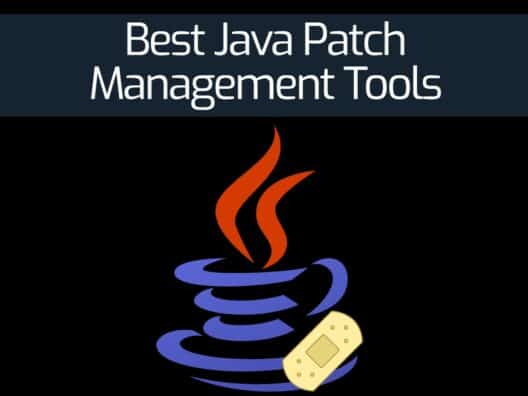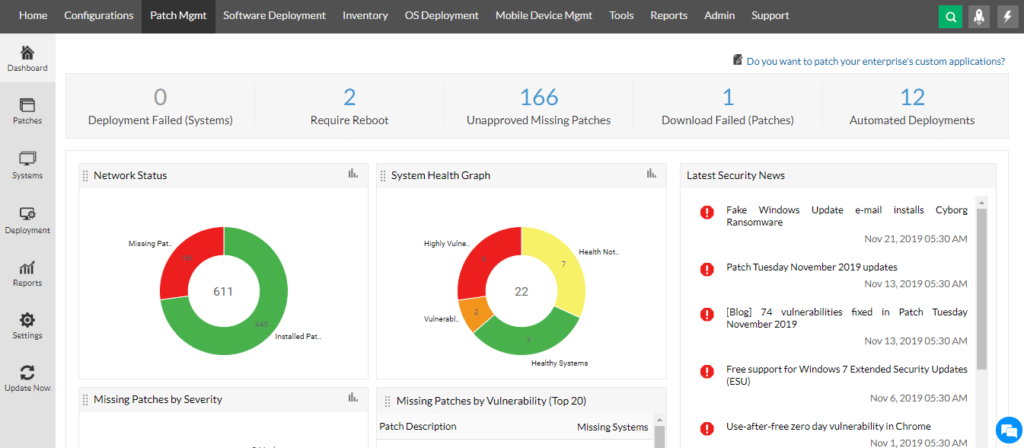Today, we'll take a look at some of the best patch management tools and software for your network infrastructure. Patching and software upgrades are critical to keeping your systems up to date for your organization. Malware and viruses, especially in light of current advances such as ransomware, are capable of compromising your data and network through poorly managed software upgrades. Exploits are less evident risks that allow hackers to get access to your network without being discovered.
Here’s our list of the Best Java Patch Management Tools:
- Atera Remote Monitoring and Management – EDITOR'S CHOICE A cloud-based Remote IT Management platform that offers MSPs, IT consultants, and IT departments a comprehensive and comprehensive solution. Start a 30-day free trial.
- ManageEngine Patch Manager Plus – FREE TRIAL A comprehensive patching solution. It can release patches to Windows, Mac, and Linux endpoints automatically. Download a 30-day free trial.
- NinjaOne Provides a comprehensive suite of tools for monitoring, managing, securing, and improving all of your network devices, as well as Windows and Mac workstations, laptops, and servers, regardless of their location.
- Syxsense Patch Management Combines desktops, laptops, and servers into a single interface.
- Ivanti When it comes to patch management Ivanti is especially effective where there is a requirement to make user interactions simple.
- SolarWinds Patch Manager A platform that automates the patching of Microsoft Servers, Workstations, and third-party applications.
- SysAid Keeps Windows-based servers and PCs up to date with the most recent security patches and updates.
- JetPatch Assists companies in proactively eliminating security defects and achieving continuous compliance across environments by managing the whole remediation chain of operations using intelligent workflow automation – backed by machine learning capabilities.
- Pulseway Patch management capabilities for patching Windows and third-party software automatically. All of the systems can be scanned, installed, and updated.
Importance of Patch Management
Let’s have a look at some of the importance of patch management:
- Security The most important and obvious advantage is improved network security. By securing your network before a breach occurs, you can avoid data theft, legal problems, and long-term reputation damage.
- Productivity Having up-to-date systems and programs reduces the number of issues and any downtime that may occur due to fixes not being implemented correctly or at all. A patch will increase productivity by keeping your systems up to date with the most recent codes.
- Compliance With the rise of cyber risks, regulations are becoming more stringent, and businesses must adhere to cybersecurity best practices. Failure to comply may result in legal consequences for your company. Patch management guarantees that you remain under these criteria.
- Remote protection Businesses worldwide support remote working these days; 70% of workers globally work from home at least one day a week. Patch management can be used as part of a remote workforce support solution to safeguard all of your company's devices, regardless of where they are located, to protect yourself.
- Innovation Keeping up with the latest innovations and updates is critical in today's environment. It appears to be evolving daily; patch management will assist you in ensuring you have the most recent software with the most recent features that could benefit your organization.
Best Server Patch Management Tools
Let’s have a look at the top 9 best Patch Management Tools on the market.
Our methodology for selecting the best Java Patch Management tool:
- We prioritize tools that significantly improve network security, helping to prevent data breaches and protect sensitive information.
- It's crucial to choose a tool that ensures systems and programs are consistently updated, reducing downtime and technical issues.
- We consider how well each tool assists businesses in adhering to evolving cybersecurity regulations and standards.
- Given the rise of remote working, tools that provide comprehensive patch management for remote systems are highly valued.
- The ability to stay updated with the latest software features and innovations plays a key role in our selection process.
1. Atera Remote monitoring and Management – FREE TRIAL
Atera's pre-tech pricing approach is economical and innovative, allowing you to manage an unlimited number of devices and endpoints for a single low price. You can choose between a flexible subscription and a discounted annual subscription. You can choose from three different licensing types and get a 30-day free trial of Atera's complete feature set.
Key Features
- For both Windows and Mac, automate crucial Patch Management operations with ease.
- To keep your devices up to date and secure, set up periodic patching profiles on a weekly or monthly basis.
- Updates, security updates, service packs, drivers and tools, and upgrades should all be installed.
- Patch deployment information and success rates can be seen in reports.
- Create testing groups with the ability to exclude patches for smoother deployment operations.
- Create software deployment and patching automation.
- There are no contracts or hidden costs, and you can cancel at any moment.
- Local Customer Support is available 24 hours a day, seven days a week, and is entirely free.
Why do we recommend it?
Atera stands out for its economical and innovative pricing approach, offering a comprehensive IT management solution that includes patch management. Its flexibility to manage an unlimited number of devices and its all-in-one package makes it an attractive choice for MSPs, IT consultants, and IT departments.
Atera is a cloud-based Remote IT Management platform that offers MSPs, IT consultants, and IT departments a comprehensive and comprehensive solution. Atera includes Patch Management Automation and Reporting in a fully integrated IT management solution, making it the ideal all-in-one RMM tool package.
Patching is accessible on all devices thanks to integrations with Chocolatey for Windows and Homebrew for Mac. Remote Monitoring and Management (RMM), PSA, Remote Access, Patch Management, Script Library, Reporting, Ticketing, Helpdesk, Billing, and much more are included in Atera.
Atera is a top option Patch Management software for MSPs and IT professionals due to its fixed pricing for unlimited devices and smoothly integrated solution.
Who is it recommended for?
Atera is particularly suitable for managed service providers (MSPs), IT consultants, and IT departments that require a versatile, cloud-based IT management platform. Its minimalistic interface and comprehensive solution set make it ideal for businesses seeking a unified approach to remote IT management.
Pros:
- Minimalistic interface makes it easy to view the metrics that matter most
- Flexible pricing model makes it a viable option for small businesses
- Includes multiple PSA features, great for helpdesk teams and growing MSPs
- Can track SLAs and includes a time-tracking option for maintenance tasks
Cons:
- Focuses heavily on MSP-related tools, other businesses may not be able to utilize multi-tenant features
Pricing starts at $129 per technician. Start a 30-day free trial. No credit card is necessary, and you'll have access to everything Atera has to offer.
2. ManageEngine Patch Manager Plus – FREE TRIAL
ManageEngine Patch Manager Plus from ManageEngine is a comprehensive patching solution. It can release patches to Windows, Mac, and Linux endpoints automatically. It can allow patching for over 650 third-party upgrades across 350 applications. It can be installed locally or in the cloud.
Key Features
- Patch Manager Plus from ManageEngine can manage and deliver patches for over 250 third-party apps, including Adobe and Java.
- It has capabilities such as customizable deployment policies and in-depth reports.
- It contains features for testing and approving fixes, declining fixes, and patching third-party apps.
Why do we recommend it?
ManageEngine Patch Manager Plus provides a comprehensive patching solution that can automate patch release across multiple platforms, including Windows, Mac, and Linux. Its ability to manage over 650 third-party upgrades across 350 applications makes it a versatile tool for diverse IT environments.
Patch compliance will be a breeze with ManageEngine Patch Manager Plus' powerful analytics and audits. Patch management reports will allow you to keep track of your patching. It will enable you to customize your deployment policies.
Who is it recommended for?
This tool is recommended for IT departments and MSPs that require a multi-platform patch management solution with deep reporting capabilities. It's particularly beneficial for organizations that need to manage a large number of third-party applications and seek a customizable deployment policy.
Pros:
- Flexible deployment options across multiple platforms
- Can be installed on both Windows and Linux platforms, making it more flexible than other on-premise options
- Offers in-depth reporting, ideal for enterprise management or MSPs
- Integrated into more applications than most patch management solutions
Cons:
- ManageEngine is a feature-rich platform that takes time to fully explore and learn
You can download a 30-day free trial.
3. NinjaOne
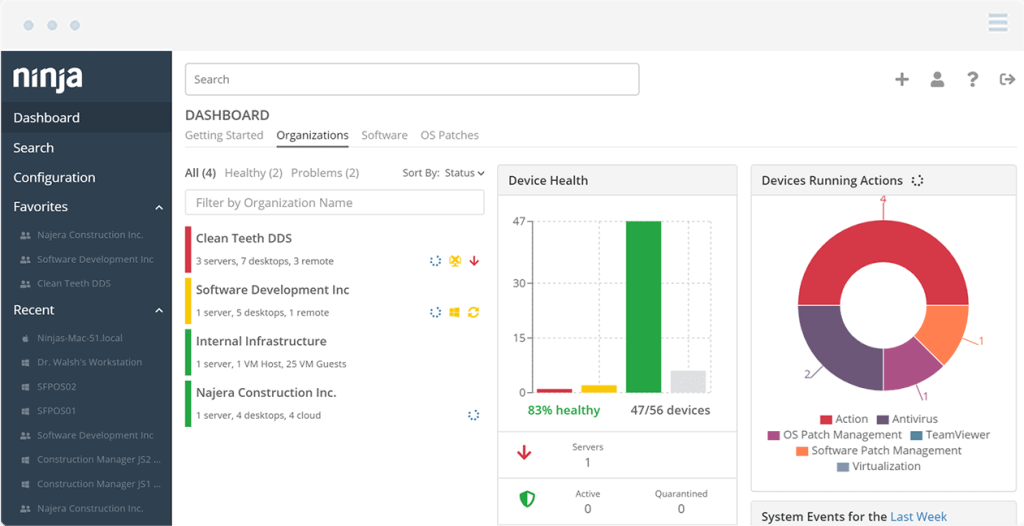
NinjaOne‘s intuitive endpoint management software includes robust automatic patch management solutions for Managed Service Providers (MSPs) and IT professionals. NinjaOne provides a comprehensive suite of tools for monitoring, managing, securing, and improving all of your network devices, as well as Windows and Mac workstations, laptops, and servers, regardless of their location. NinjaOne was designed to be the next generation of IT management software. It is quick, available from anywhere, and simple to use. They work hard to ensure that their platform is easy to use, has a beautiful user interface, and provides a consistent user experience across the web and mobile.
Key Features:
- With granular control over features, drivers, and security updates, you can automate OS and third-party program patching for Windows and macOS devices.
- Keep track of the health and productivity of your Windows and macOS workstations, laptops, and servers.
- Obtain complete hardware and software inventories.
- Using a robust set of remote tools, you may remotely manage all of your devices without interfering with end-users.
- With robust IT automation, you can standardize device deployment, configuration, and management.
- Take direct control of devices via remote access.
Why do we recommend it?
NinjaOne is known for its intuitive endpoint management software and robust automatic patch management solutions. Its comprehensive toolset for monitoring, managing, securing, and improving network devices, including Windows and Mac systems, makes it a top choice for MSPs and IT professionals.
NinjaOne has created a robust, user-friendly IT management platform that promotes efficiency, decreases ticket volumes, increases ticket resolution times, patches successfully, and is well-liked by IT professionals.
Who is it recommended for?
NinjaOne is best suited for managed service providers and IT professionals looking for an all-encompassing IT management solution. Its user-friendly platform is especially beneficial for those who require efficient, automated patch management and maintenance tasks across diverse environments.
Pros:
- Can silently install and uninstall applications and patches while the user works
- Patch management and other automated maintenance tasks can be easily scheduled
- Platform agnostic web-based management
Cons:
- Lacks support for mobile devices
4. Syxsense
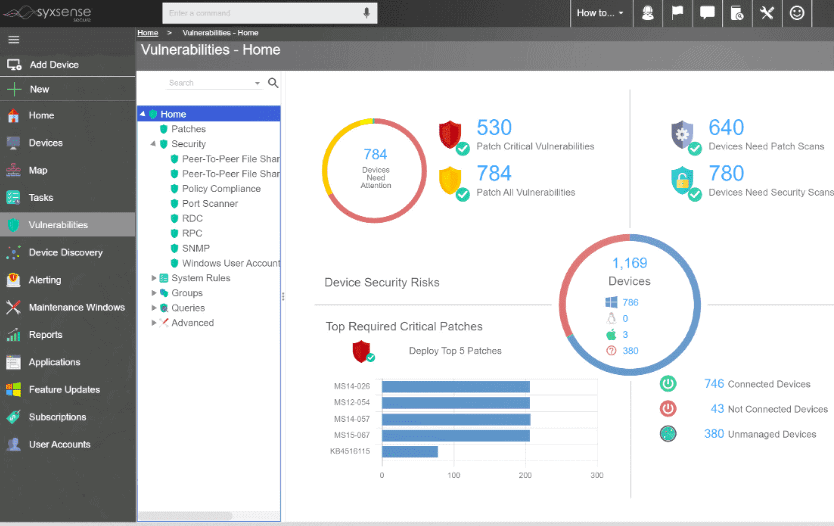
Syxsense Patch Management combines desktops, laptops, and servers into a single interface. With cross-platform support for Windows, legacy operating systems such as Windows 7, Windows 10 Feature Updates, Hyper-V, VMware, Mac, and Linux, you can identify and address all endpoint vulnerabilities both inside and outside your network.
Key Features
- Everything should be patched.
- Older versions of Windows 10 will no longer be supported by Microsoft. Your patches will be rolled back if you can't apply Feature Updates, and your devices will remain vulnerable. Their dashboard displays an accurate tally of all your Windows 10 versions, highlighting those that require immediate attention.
- Keep up with the ongoing barrage of security risks and fixes for third-party software like Adobe, Java, Chrome, etc.
- Keep track of the success of your patching and security approach. Security Risk Assessment, Most Vulnerable Devices, and Task Summary reports can be sent automatically or exported as interactive reports.
Why do we recommend it?
Syxsense Patch Management is notable for its unified interface that combines desktops, laptops, and servers, offering cross-platform support. Its capability to patch legacy operating systems and third-party software, along with its focus on security, makes it a strong contender in the patch management space.
Syxsense keeps desktops, laptops, servers, and remote users up to speed with the latest security patches and software upgrades from Microsoft, Windows 10 Feature Updates, macOS, Linux, and third-party vendors such as Adobe, Java, and Chrome.
Patch virtual machines, legacy operating systems, and IoT devices as well. Patch commands like Critical, Top 10 Windows, and Third-Party, as well as automatic and pre-built Patch commands, will make you look like you have a Ph.D. in Patch Management.
Who is it recommended for?
This tool is ideal for IT teams who need a cloud-based service for flexible desktop management, particularly those managing remote teams. Its simple user interface and flexible pricing make it suitable for networks of any size, from small businesses to large enterprises.
Pros:
- Simple and intuitive user interface, great use of color to display key metrics
- Cloud-based service makes desktop management flexible, especially for remote teams
- Flexible pricing makes it a great choice for any size network
- Offers configuration profiles that streamline onboarding new devices
Cons:
- Would benefit from a longer 30-day trial period
5. Ivanti
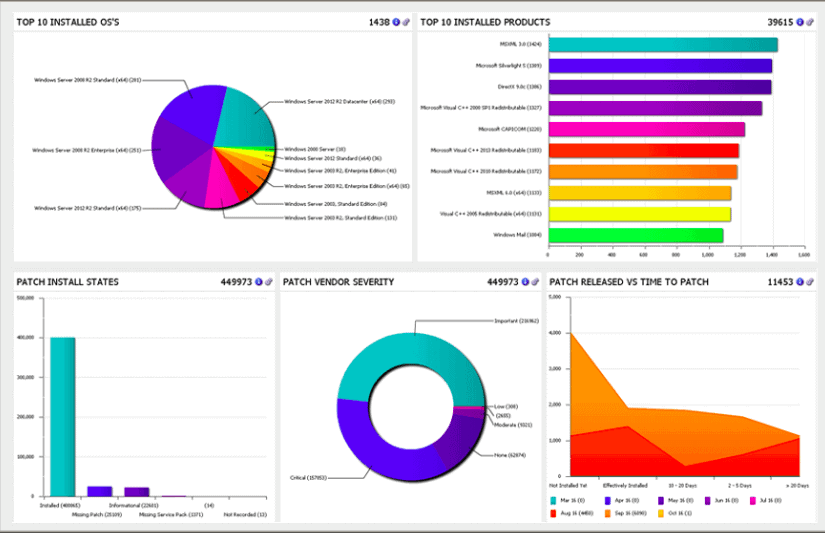
Patch Management for Windows is one of the better patch management tools, capable of keeping both physical and virtual Windows systems, as well as third-party programs, up to date.
Key Features
- There's also Ivanti Patch for Windows, powered by Shavlik, and Patch for Linux, Unix, and Mac, powered by Heat. These are more straightforward options that can be up and operating in less than an hour.
- Ivanti Patch for Windows supports VMware vSphere integration for managing hypervisor patching and offline VMs and templates.
- Ivanti has a dedicated content team that uses automated tools to deliver a continual stream of information. Its patch catalog is updated twice weekly, and it offers Zero-Day support with out-of-band releases to respond to crucial security patches the same day.
Why do we recommend it?
Ivanti is effective in patch management, particularly in simplifying user interactions. It is capable of keeping both physical and virtual Windows systems, as well as third-party programs, up to date, making it a versatile tool for diverse IT environments.
If you want to maintain your network free of viruses and malware, you'll need to keep up with operating system upgrades, so picking the correct patch management solution is crucial. Ivanti recognizes that most large enterprises must maintain numerous patching tools to keep their physical and virtual servers up and operating simultaneously, which is inefficient.
When it comes to patch management, Ivanti is especially effective where there is a requirement to make user interactions simple.
The Windows Patch Management System can handle every Windows Operating System component, paying close attention to everything from hypervisor updates to third-party programs and apps.
It also determines which patches, and fixes, and security upgrades, must be installed on a specific system. After the patching is completed, you will receive a patch report detailing the work that has been completed.
Who is it recommended for?
Ivanti is recommended for large enterprises that require a comprehensive patch management solution capable of handling complex networks. It's particularly suitable for environments that need to manage a mix of physical and virtual servers, as well as third-party applications.
Pros:
- Multi-platform support for Linux, Mac, and Unix gives the tool flexibility in diverse networks
- Offers Patch scheduling in addition to imaging
- Offers simple graphical reporting which is easy to setup
Cons:
- Must contact company for exact pricing
6. SolarWinds Patch Manager
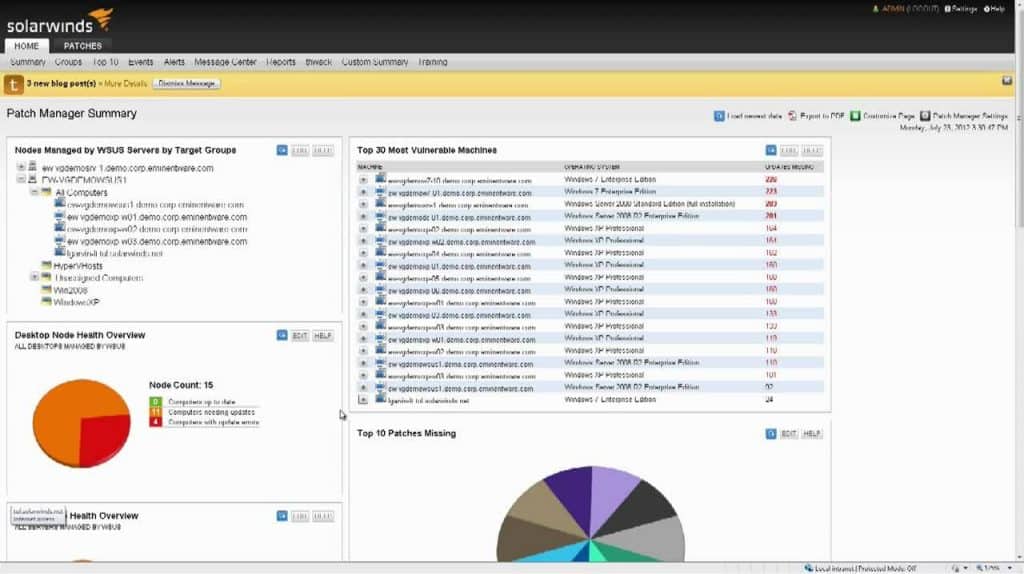
SolarWinds Patch Manager is a platform that automates the patching of Microsoft Servers, Workstations, and third-party applications. Patch management on servers and workstations is made more accessible with SolarWinds. It has an automated patching and reporting feature. SolarWinds Patch Manager makes it simple to manage third-party patches across tens of thousands of servers and workstations. It allows you to leverage and expand the capabilities of Microsoft WSUS or SCCM to report, apply, and manage both third-party and Microsoft fixes.
Key Features
- Patching real and virtual Windows desktops and servers with pre-built, tested fixes from vendors such as Adobe, Apple, Google, Mozilla, Oracle, and others can be done in minutes rather than weeks.
- SolarWinds Patch Manager will reduce security threats while also limiting service outages.
- It will assist you in guaranteeing patch application and regulating what is patched and when.
- Patch Manager's web interface displays critical patch management data with other SolarWinds products in an integrated web portal. You may see the most recently available patches, the top ten missing patches in your environment, and a general health overview depending on which patches have been deployed.
- With the help of the most recent updates for third-party programs, you will be able to keep your desktops, laptops, servers, and virtual machines patched and secure.
- It generates summary reports that show the status of patching.
- SolarWinds Patch Manager supplements your Microsoft SCCM setup with pre-tested, pre-built third-party updates and offers numerous time-saving management capabilities to help you get the most out of your Configuration Manager investment.
- SolarWinds Patch Manager provides simple and robust reporting tools to help you evaluate the status of patches and demonstrate to auditors that systems are patched and compliant – or identify those that are not.
Why do we recommend it?
SolarWinds Patch Manager is an excellent choice for automating the patching process of Microsoft Servers, Workstations, and third-party applications. Its capability to manage patches across thousands of servers and workstations, along with its integration with Microsoft WSUS and SCCM, makes it a robust and efficient tool for large-scale environments.
SolarWinds' Patch Management software includes a Patch status dashboard and Patch compliance reports. It has pre-built/pre-tested packages, vulnerability management, and Microsoft WSUS patch management features.
Who is it recommended for?
This tool is ideal for IT professionals and system administrators in large enterprises who need a powerful solution to manage and automate patching processes across extensive networks, including both real and virtual Windows desktops and servers.
Pros:
- Simple dashboard makes it easy to track and visual patches and their progress, even on larger networks
- Integrated directly with SCCM for a smoother patch deployment
- Supports a wide variety of third-party patching options
Cons:
- The tool is very enterprise focused, may not be the best option for home labs or small networks
You can test out SolarWinds Patch Manager through a fully functional 30-day free trial.
7. SysAid
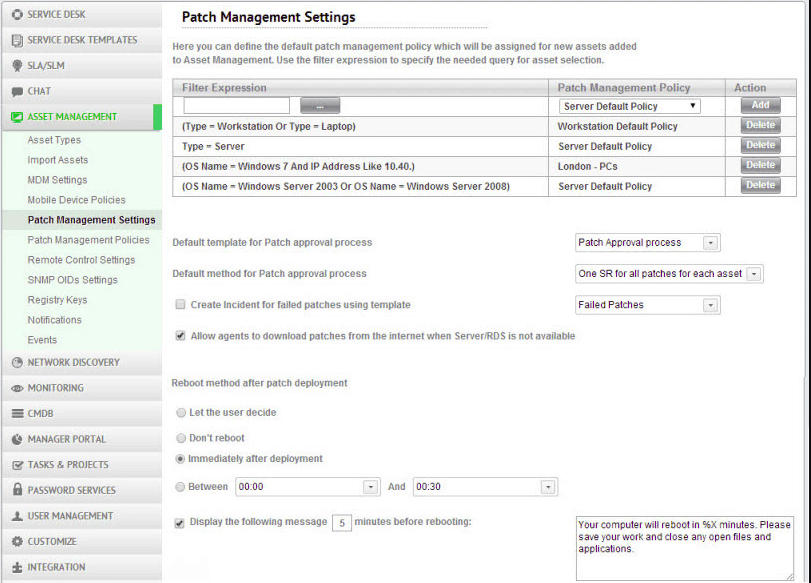
ITSM, Service Desk, and Help Desk Software are all available from SysAid. The SysAid IT Asset Management system includes Patch Management functionalities. It can keep Windows-based servers and PCs up to date with the most recent security patches and updates. In today's IT world, there seems to be an ongoing requirement to apply software patches to your computer estate, which may be required for bug fixes, security updates, or just to offer new functionality. SysAid Patch Management combines OEM technology with SysAid to give a complete patch management solution.
Key Features
- SysAid Patch Management is based on OEM technology, allowing for complete and smooth patch management.
- It will assist the IT administrator in obtaining a comprehensive overview of all fixes relevant to active IT assets.
- It gives you the option of customizing your solution.
- You'll be able to apply fixes to multiple or single assets manually.
- You can track the patch deployment process and see the outcomes.
- Get a list of all the patches that are apply to your organization's active IT assets.
- As needed, customize the automatic SysAid Patch Management policies.
- Manage patches on multiple or individual assets manually.
- Approve patch deployment using a formal change management approach, such as that recommended by ITIL.
- View the outcomes of patch deployments and track their progress.
Why do we recommend it?
SysAid Patch Management stands out for its integration of OEM technology, offering a seamless and comprehensive solution for patch management. It's particularly effective in providing a detailed overview of all pertinent patches for IT assets, enhancing both security and functionality.
SysAid Patch Management is a patch management solution for Microsoft products and third-party software including Adobe, Java, and Google Chrome. This system is simple to install, fully automated, extremely configurable, and expandable. It's available both on-premises and in the cloud.
Who is it recommended for?
This tool is ideal for IT administrators who need a robust and customizable patch management system. It's especially suitable for those managing Windows-based servers and PCs, requiring a mix of security updates, bug fixes, and new functionalities across their computer estate.
Pros:
- Offers SNMP monitoring through a simple plugin
- Flexible pricing options allow you to choose the features you pay for
- Good option for those looking for SNMP monitoring and patching solution
Cons:
- Lacks enterprise features – better suited for small to medium size networks
8. JetPatch
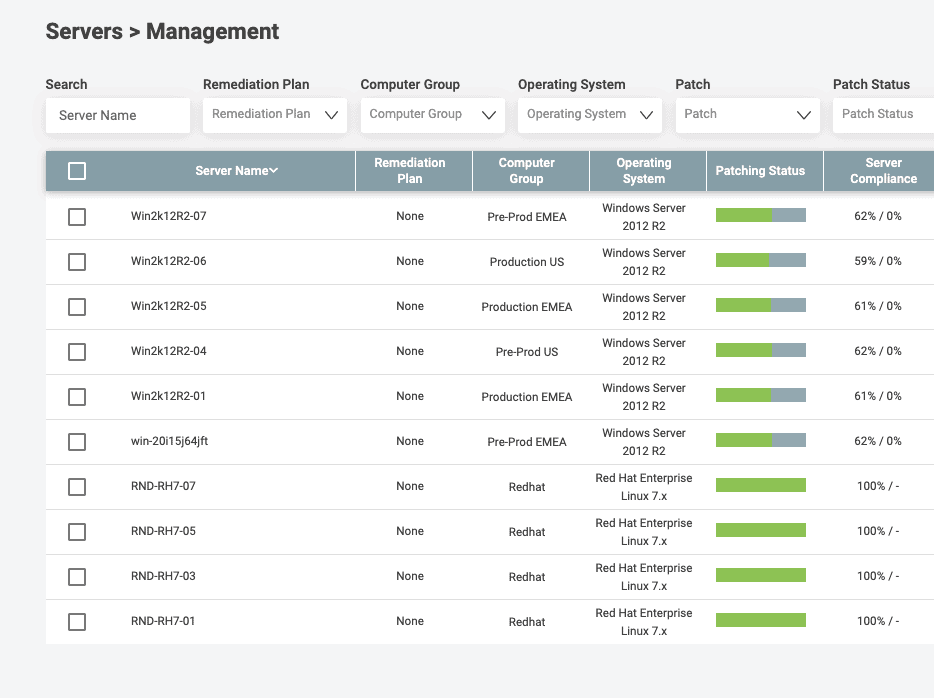
New IT vulnerabilities are being discovered at an alarming rate, causing IT/InfoSec teams to become overburdened and compromising compliance readiness. Unpatched vulnerabilities account for 70% of all security breaches. At the time of the breach, the majority of enterprises had an active patch management solution. So, where did it all go wrong? Current solutions are only concerned with deploying the requisite software fixes and do not consider the ecosystem's complexity, the various teams engaged, or the widespread use of current tools and regulations.
Key Features
- In a single, easy-to-understand dashboard, you can see and analyze the whole patch and vulnerability remediation process.
- JetPatch's vulnerability database uses CVE, NIST, and other well-known industry databases to enable ongoing baseline and patch availability tracking.
- JetPatch works with your existing vendor-supplied or third-party patch management, providing centralized control and automation.
- There will be no more silos. Bring all vulnerability fixes and patch rollouts together in one place.
Why do we recommend it?
JetPatch is recommended for its comprehensive approach to patch and vulnerability remediation. It excels in offering a unified dashboard that integrates well with existing patch management systems, providing centralized control and automation backed by intelligent workflow automation and machine learning capabilities.
By bringing a new end-to-end approach to vulnerability remediation, the JetPatch cloud-based solution disturbs the areas of corporate risk compliance and vulnerability & risk management. JetPatch assists companies in proactively eliminating security defects and achieving continuous compliance across environments by managing the whole remediation chain of operations using intelligent workflow automation – backed by machine learning capabilities.
Who is it recommended for?
JetPatch is best suited for larger networks and organizations seeking an end-to-end solution for vulnerability remediation and risk management. It's ideal for teams that require a holistic view of their patching process, integrating various tools and regulations into a cohesive system.
Pros:
- Provides granular control for automated patching and scanning
- Can automatically identify new devices that require patching
- Supports on-premise, cloud, and hybrid cloud network configurations
- Great interface
Cons:
- Better suited for larger networks
9. Pulseway
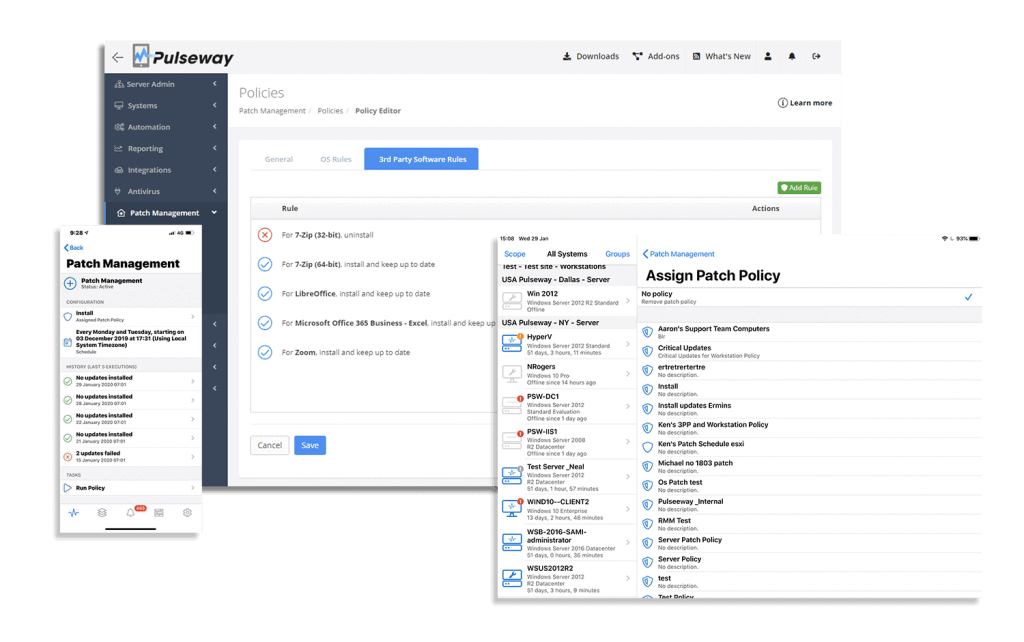
The Remote Monitoring and Management solution is provided by Pulseway. It has patch management capabilities for patching Windows and third-party software automatically. All of the systems can be scanned, installed, and updated.
Key Features
- Pulseway allows you to plan the update for specific dates and intervals.
- It works with a various programs, including Adobe Acrobat Reader DC, GoToMeeting, Mozilla Firefox, and others.
- Third-party patching options will keep your apps up to date, ensuring the security of your IT infrastructure.
Why do we recommend it?
Pulseway Patch Management is recognized for its versatility and automation capabilities, supporting multi-platform deployments and offering automated patching for both Windows and common third-party applications. Its custom script library adds a layer of flexibility for tailored updates.
Who is it recommended for?
Pulseway is recommended for IT professionals looking for a comprehensive yet user-friendly patch management solution. It's particularly suitable for environments that include Linux, Windows, and Mac systems, and is ideal for small to medium-sized deployments.
Pros:
- Has a freeware version for small deployments and testing
- Supports multi-platform deployments like Linux, Windows, and Mac
- Automated patching can run Windows updates as well as updates for common apps such as Adobe or Dropbox
- Custom script library allows you to build and run fixes at will, or through a scheduler
Cons:
- The interface could use improvement
Conclusion
If you want to have trouble-free computing in your firm, you must keep your infrastructure up to date. Patching is vital for various reasons, the most significant of which is to keep your company's information safe while preventing hackers and cybercriminals from gaining access to your network.
Patching management tools can help you automate this procedure significantly, even allowing you to upgrade your apps to the most recent, more secure versions. There are so many diverse options available that it's tough to suggest just one.
Many of the best Java Patch Manager we've shown you today include free versions that may be used for a trial period before being purchased if you find the app useful. We hope you found all of this information helpful and that you can now make an informed decision!

